
1793 (MDCCXCIII) was a common year starting on Tuesday of the Gregorian calendar and a common year starting on Saturday of the Julian calendar, the 1793rd year of the Common Era (CE) and Anno Domini (AD) designations, the 793rd year of the 2nd millennium, the 93rd year of the 18th century, and the 4th year of the 1790s decade. As of the start of 1793, the Gregorian calendar was 11 days ahead of the Julian calendar, which remained in localized use until 1923.

Marie Antoinette was the last queen consort of France prior to the French Revolution. She was born an archduchess of Austria, and was the penultimate child and youngest daughter of Empress Maria Theresa and Emperor Francis I. She married Louis XVI, heir apparent to the French throne, in 16 May 1770 at age 14. She became dauphine of France. On 10 May 1774, her husband ascended the throne as Louis XVI and she became queen.

Louis XVI was the last king of France before the fall of the monarchy during the French Revolution.

Louis XVII was the younger son of King Louis XVI of France and Queen Marie Antoinette. His older brother, Louis Joseph, Dauphin of France, died in June 1789, a little over a month before the start of the French Revolution. At his brother's death he became the new Dauphin, a title he held until 1791, when the new constitution accorded the heir apparent the title of Prince Royal.

The royal Flight to Varennes during the night of 20–21 June 1791 was a significant event in the French Revolution in which King Louis XVI of France, Queen Marie Antoinette, and their immediate family unsuccessfully attempted to escape from Paris to Montmédy, where the King wished to initiate a counter-revolution by joining up with royalist troops. They escaped as far as the small town of Varennes-en-Argonne, where they were arrested after being recognized at their previous stop in Sainte-Menehould.

Jeanne Bécu, Comtesse du Barry was the last maîtresse-en-titre of King Louis XV of France. She was executed by guillotine during the French Revolution on accusations of treason—particularly being suspected of assisting émigrés to flee from the Revolution. She is also known as “Mademoiselle Vaubernier”.

Jean-Baptiste Lemoyne was a French sculptor of the 18th century who worked in both the rococo and neoclassical style. He made monumental statuary for the Gardens of Versailles but was best known for his expressive portrait busts.
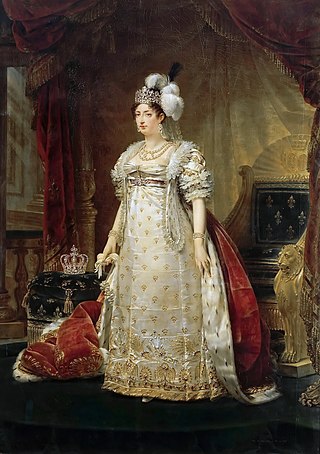
Marie-Thérèse Charlotte was the eldest child of King Louis XVI and Queen Marie Antoinette of France, and their only child to reach adulthood. In 1799 she married her cousin Louis Antoine, Duke of Angoulême, the eldest son of Charles, Count of Artois, henceforth becoming the Duchess of Angoulême. She was briefly Queen of France in 1830.

Marie-Jeanne "Rose" Bertin was a French fashion merchant. She was particularly noted for her work with Queen Marie Antoinette. Bertin was the first celebrated French fashion designer and is widely credited with having brought fashion and haute couture to the forefront of popular culture.

"Let them eat cake" is the traditional translation of the French phrase "Qu'ils mangent de la brioche", said to have been spoken in the 18th century by "a great princess" upon being told that the peasants had no bread. The French phrase mentions brioche, a bread enriched with butter and eggs, considered a luxury food. The quote is taken to reflect either the princess's frivolous disregard for the starving peasants or her poor understanding of their plight.

The pouf or pouffe also "toque" is a hairstyle and a hairstyling support deriving from 18th-century France. It was made popular by the Queen of France, Marie Antoinette (1755–1793), when she wore it in June 1775 at the coronation of her husband Louis XVI, triggering a wave of French noblewomen to wear their hair in the same manner. The hairstyle would become popular across Europe in the 1770s.

La Révolution française is a two-part 1989 historical drama co-produced by France, Germany, Italy and Canada for the 200th anniversary of the French Revolution. The full film runs at 360 minutes, but the edited-for-television version is slightly longer. It purports to tell a faithful and neutral story of the Revolution, from the calling of the Estates-General to the death of Maximilien de Robespierre. The film had a large budget and boasted an international cast. It was shot in French, German and English.
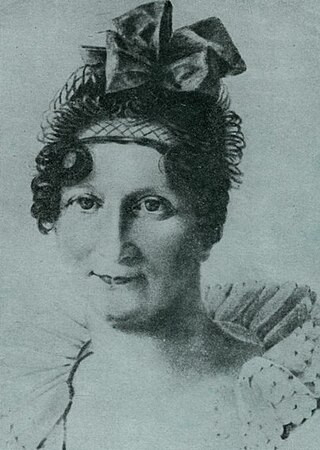
Agathe de Rambaud was the official nurse of the royal children, and particularly was in charge of the Dauphin from 1785 to 1792. She was born in Versailles as Agathe-Rosalie Mottet and was baptized in the future cathedral Saint-Louis of Versailles, on 10 December 1764. She died in Aramon, in the département of Gard, on 19 October 1853.
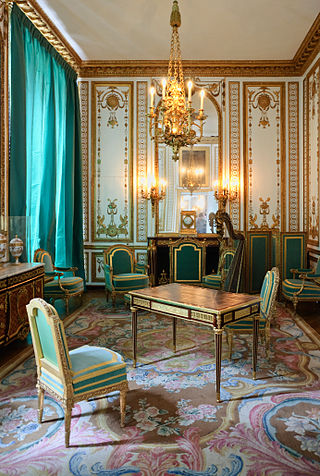
Louis XVI style, also called Louis Seize, is a style of architecture, furniture, decoration and art which developed in France during the 19-year reign of Louis XVI (1774–1792), just before the French Revolution. It saw the final phase of the Baroque style as well as the birth of French Neoclassicism. The style was a reaction against the elaborate ornament of the preceding Baroque period. It was inspired in part by the discoveries of Ancient Roman paintings, sculpture and architecture in Herculaneum and Pompeii. Its features included the straight column, the simplicity of the post-and-lintel, the architrave of the Greek temple. It also expressed the Rousseau-inspired values of returning to nature and the view of nature as an idealized and wild but still orderly and inherently worthy model for the arts to follow.
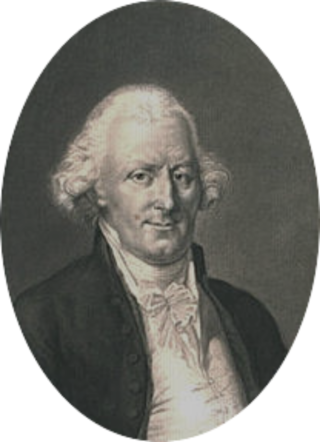
Jean-Baptiste Michonis was a personality of the French Revolution. Originally a producer of lemonade, he became a member of the Commune de Paris, inspector of prisons and chief of police. He participated in the "complot de l'œillet", a failed attempt to rescue Marie-Antoinette organised by Jean, Baron de Batz, and for this was guillotined in what is now the Place de la Nation. He was buried in the cimetière de Picpus.
Pauline de Tourzel was a French noblewoman, courtier and memoirist. She was the daughter of Louise Élisabeth de Croÿ.
Armand-Benoît-Joseph Guffroy was a lawyer and politician of the French Revolution. He was born at Arras and died in Paris, aged 58.

Louis XVI, former King of France since the abolition of the monarchy, was publicly executed on 21 January 1793 during the French Revolution at the Place de la Révolution in Paris. At his trial four days prior, the National Convention had convicted the former king of high treason in a near-unanimous vote; while no one voted "not guilty", several deputies abstained. Ultimately, they condemned him to death by a simple majority. The execution by guillotine was performed by Charles-Henri Sanson, then High Executioner of the French First Republic and previously royal executioner under Louis.
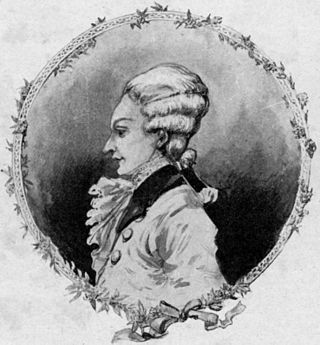
Léonard-Alexis Autié, also Autier, often referred to simply as Monsieur Léonard, was the favourite hairdresser of Queen Marie Antoinette and in 1788–1789 founded the Théâtre de Monsieur, "the first resident theatre in France to produce a year-round repertory of Italian opera."

Jean-François Autié was a hairdresser to Queen Marie Antoinette. He was the youngest brother of Léonard-Alexis Autié and Pierre Autié, who were also hairdressers at the royal court. All three brothers used the professional name of Monsieur Léonard.
















